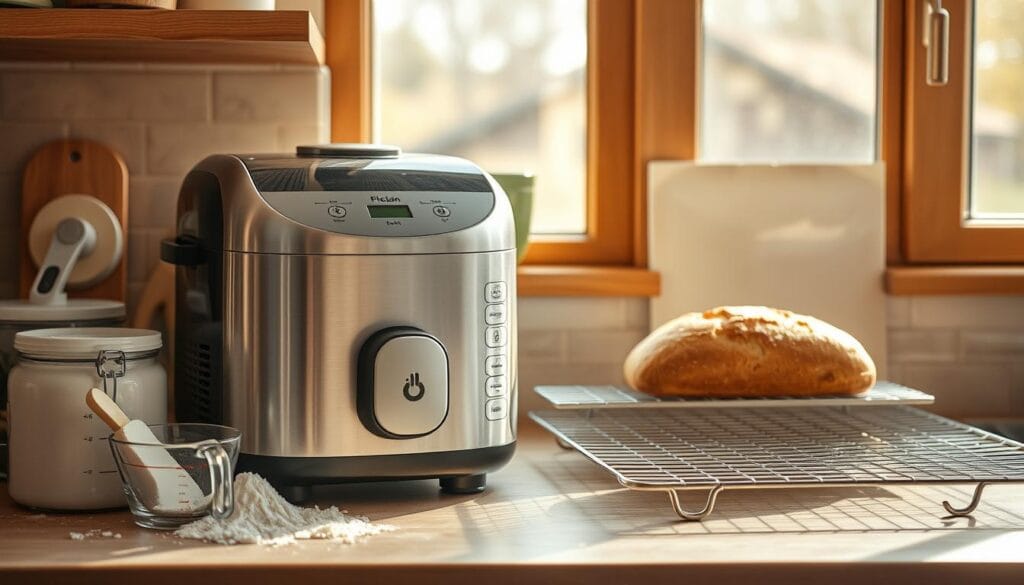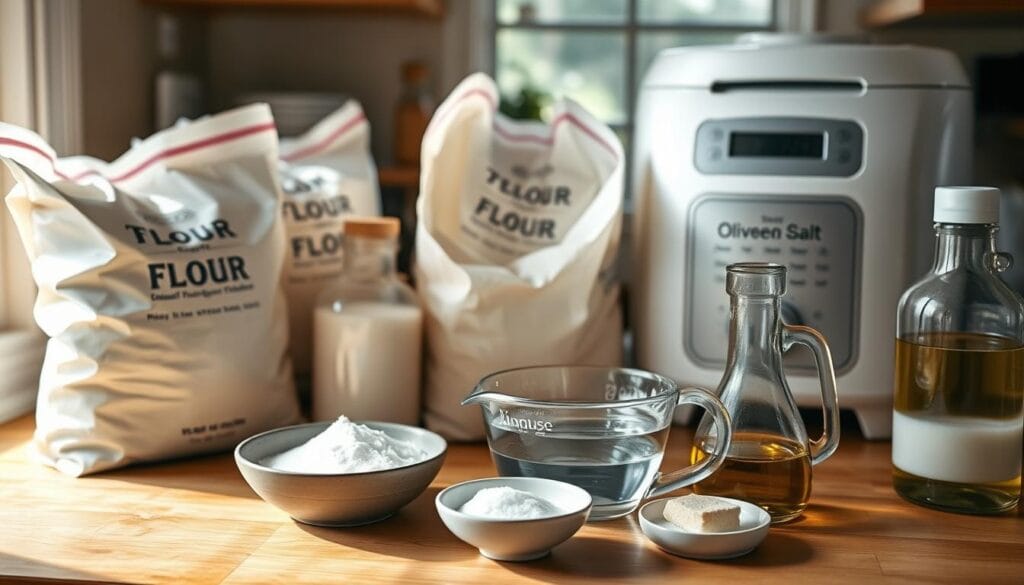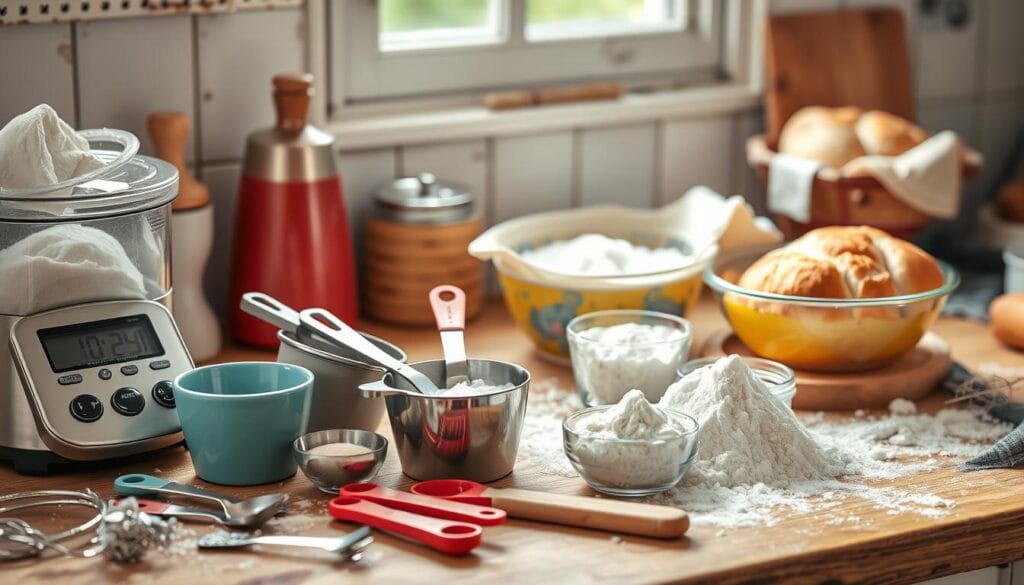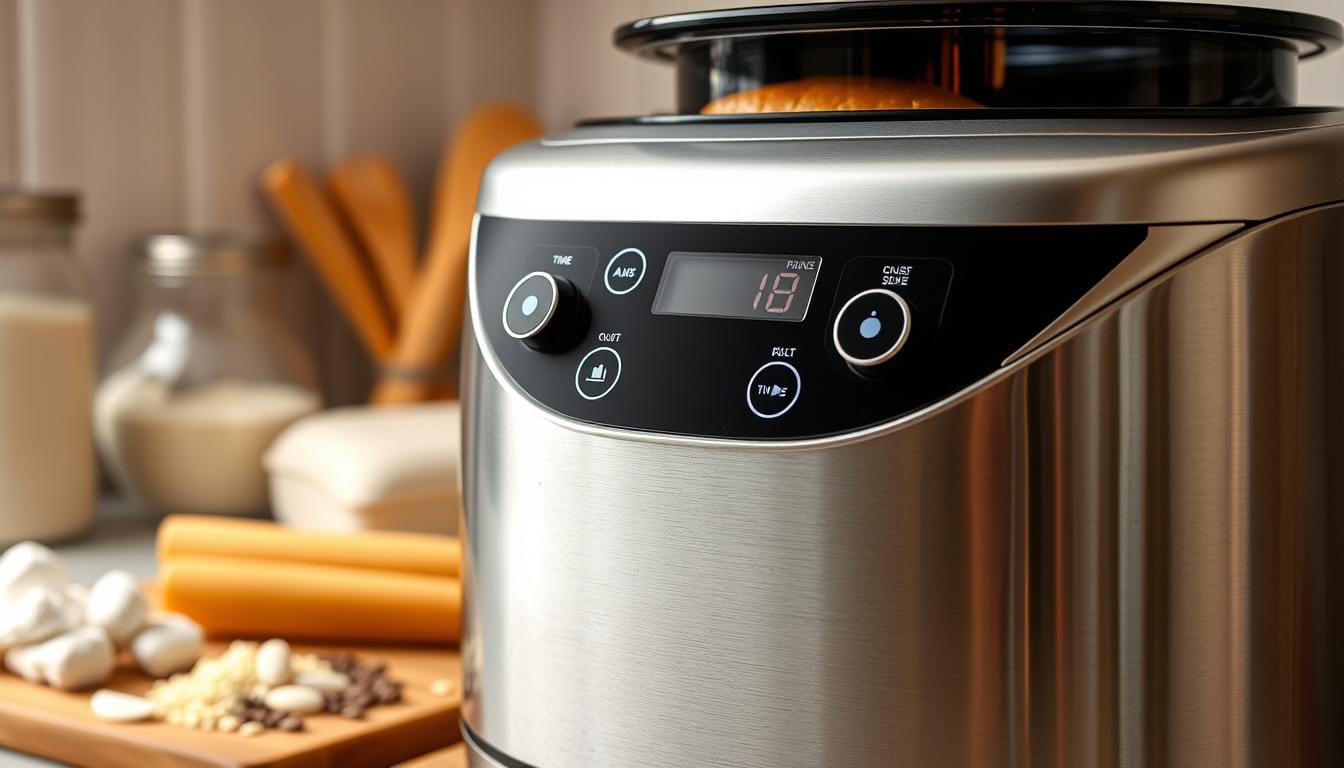Imagine waking up to the smell of freshly baked bread. It’s made easy with a simple bread machine recipe. This recipe is perfect for a 2 lb bread machine. It’s designed to be easy and delicious, so you can make homemade bread without the hassle.
This recipe takes 3 hours and 35 minutes to make, yielding 12 servings. It’s great for families and individuals who love freshly baked bread. You’ll need basic ingredients like water, sugar, salt, butter, and bread flour. This makes it easy for anyone with a bread machine to use.

Many users have tested and reviewed this recipe, with 47.2K shares. People love it, giving it high satisfaction ratings. You can customize it to your taste, using whole wheat flour or choosing different crusts. Whether you’re new to baking or experienced, this recipe is a great place to start.
Table of Contents
Essential Equipment and Ingredients for Your 2 lb Bread Recipe for Breadmaker
To make a delicious 2 lb bread, you need the right tools and ingredients. The bread machine is key, and knowing its settings is important. For a white bread recipe, you’ll need flour, yeast, sugar, and salt.
The quality of flour is crucial. King Arthur Unbleached All-Purpose Flour is a top choice for bakers. You’ll also need water, egg, butter, and yeast for the dough.
Required Equipment and Tools
Here’s what you need to make bread with a bread machine:
- Bread machine
- Measuring cups and spoons
- Mixing bowl
- Wooden spoon or spatula
Basic Ingredients List
Here’s what you need for the white bread recipe:
- 3 cups of flour
- 1 teaspoon of salt
- 1 tablespoon of sugar
- 1 packet of active dry yeast
- 1 cup of water
- 1 egg
- 4 tablespoons of butter

Optional Ingredients for Variations
You can add optional ingredients for different flavors:
- Herbs and spices
- Garlic or onion powder
- Whole wheat flour or other types of flour
With the right equipment and ingredients, you can make a tasty 2 lb bread. Follow the recipe and instructions for the best results.
| Ingredient | Quantity |
|---|---|
| Flour | 3 cups |
| Salt | 1 teaspoon |
| Sugar | 1 tablespoon |
| Yeast | 1 packet |
| Water | 1 cup |
| Egg | 1 |
| Butter | 4 tablespoons |
Understanding Your Bread Machine Settings
To get perfect results, knowing your bread machine settings is key. The right cycle and settings can greatly affect your bread machine recipe. For example, the basic white bread cycle is common, but you can also try custom settings for different bread types.
Choosing the right cycle for your recipe is crucial. Some machines have special settings for quick breads. For instance, the “Quick Bread” or “Cake” setting is great for baking quick breads. Knowing these settings helps solve baking problems and ensures your bread machine recipe turns out right.
Here are some important points to remember when using your bread machine settings:
- Choose the right cycle for your recipe
- Adjust the settings as needed for custom recipes
- Understand the different settings for various types of bread, such as quick breads or white bread
By understanding your bread machine settings and their impact on your bread machine recipe, you’ll make delicious homemade bread easily. Always check your machine’s manual for specific instructions and guidelines on using different settings and cycles.
Measuring Ingredients for Perfect Results
When making bread in a machine, getting the ingredients right is key. It’s important to measure things like flour, yeast, and liquids carefully. This ensures your bread turns out just right.
To measure flour, just spoon it into a cup and level it off. This way, you avoid packing the flour down. For liquids, use a measuring cup to get it right. For example, a two-pound loaf needs 1 cup of warm water and 1/3 cup of milk.

Measuring ingredients is a big part of making bread. By following these tips, you can make delicious bread with your machine. Always keep the right balance of liquid to fat, and remember to add yeast and salt correctly. With a bit of practice, you’ll make perfect bread every time.
Proper Flour Measurement Techniques
Getting flour measurement right is crucial for the bread’s texture. Accurate flour measurement helps your bread be light and fluffy, not dense.
Liquid Ingredient Accuracy
Measuring liquids accurately is also key when making bread in a machine. It ensures your bread has the right moisture and flavor.
Yeast Measurement Tips
Yeast measurement is important too. Measuring it correctly helps your bread rise well and taste great.
Step-by-Step Mixing Process
To start mixing your bread machine recipe, put the ingredients in the machine. Make sure to follow the order suggested by the manufacturer. This usually means adding flour, sugar, salt, and yeast first. Then, add the liquids like water and melted butter.
The mixing process is easy, thanks to the bread machine. But, keep an eye on the dough during the kneading cycle, which lasts about 3-5 minutes. If the dough seems too sticky or dry, you can tweak it by adding flour or water a little at a time.
Here’s a quick guide to the mixing steps:
- Add dry ingredients to the bread machine
- Add liquid ingredients to the machine
- Set the machine to the “dough” cycle
- Monitor the dough consistency during the kneading cycle
- Adjust the consistency as needed
By following these steps and using the right ingredients, you can make a tasty loaf of bread. The bread machine recipe is simple and requires little effort. It’s great for anyone who wants to bake bread at home.
| Ingredient | Quantity |
|---|---|
| Flour | 3 cups |
| Water | 1 cup |
| Sugar | 1/4 cup |
| Salt | 1 1/4 teaspoons |
| Quick-rise yeast | 1 tablespoon |
Choosing the Right Cycle for Your Bread
Choosing the right cycle is key when baking bread with a bread machine. The bread machine settings and cycle options greatly affect the final loaf. It’s important to know the different cycles available, like basic white bread, whole grain, and custom options.
Think about the bread type and ingredients you’re using. For a classic white bread, the basic white bread cycle is perfect. It makes a light crust and soft inside. But, for whole grain bread, use the whole grain settings. It’s better for coarser grains and denser loaves.
Many bread machines also have custom programming options. This lets you create a cycle for your needs. You can change rising time, baking time, and temperature. With the right cycle options and bread machine settings, you can make professional-quality bread at home.
Monitoring the Baking Process
When you use a bread machine recipe, it’s key to watch the baking closely. This ensures your bread comes out just right. You can check the bread through the machine’s window or use a thermometer for the inside temperature.
A bread machine recipe mixes flour, yeast, and water. The baking process can change based on flour type, ingredient temperature, and air humidity. Watching the baking lets you tweak the recipe for the best loaf.
Here are some tips for keeping an eye on the baking: * Regularly check the bread’s progress to prevent overcooking or undercooking * Use a thermometer to check the bread’s internal temperature * Adjust the recipe as needed for the perfect loaf * Watch the bread’s texture and color to ensure even baking
| Ingredient | Quantity | Importance in Baking Process |
|---|---|---|
| Flour | 2-3 cups | Provides structure and texture to the bread |
| Yeast | 1-2 teaspoons | Helps the bread rise and gives it a light texture |
| Water | 1-2 cups | Helps to create a moist and even crumb |
By following these tips and monitoring the baking, you can make a delicious, perfect loaf of bread with your bread machine recipe.
Troubleshooting Common Bread Machine Issues
Using a bread machine can sometimes lead to problems with your bread. We’ve found solutions for common issues.
Issues like collapsed loaves, texture problems, and crust issues can happen. They might be due to yeast problems, dough consistency, or wrong ingredient amounts.
To fix these problems, knowing how to troubleshoot is key. Here are some tips to help you:
- Check your yeast: Old or expired yeast can lead to poor rise or texture, causing about 30% of failures.
- Monitor dough consistency: The dough should be soft and slightly tacky for best results. Wrong consistency is a problem in about 25% of cases.
- Adjust ingredient measurements: More than 50% of failures are due to wrong ingredient amounts. This shows how important it is to measure right.
By following these tips, you can solve common bread machine problems. This way, your bread will always be perfect. Always check your bread machine’s manual for more specific help.
With time and effort, you’ll get better at fixing bread machine issues. You’ll enjoy making delicious homemade bread.
| Issue | Cause | Solution |
|---|---|---|
| Collapsed loaves | Yeast issues, dough consistency | Check yeast, adjust dough consistency |
| Texture problems | Ingredient measurement errors | Adjust ingredient measurements |
| Crust issues | Yeast issues, dough consistency | Check yeast, adjust dough consistency |
Creative Variations for Your Basic Recipe
Now that you’ve got the hang of the basic 2 lb bread recipe, it’s time to get creative. You can make your bread machine recipe even better with a few tweaks. Try out different ingredients to create a variety of tasty breads for any occasion.
Think about adding herbs and garlic for a savory twist, or go for sweet options like cinnamon raisin or fruit-filled bread. You can also play with different flours, like whole wheat or rye, to make a multi-grain bread.
- Herb and garlic bread: Add some chopped fresh herbs like rosemary or thyme, and a few cloves of garlic to your basic bread machine recipe.
- Sweet bread options: Try adding some sugar, cinnamon, or dried fruit to create a sweet bread machine recipe.
- Multi-grain alternatives: Experiment with different types of flour, such as whole wheat, rye, or oat flour, to create a unique bread machine recipe.
Remember, the secret to great creative variations is to have fun and experiment. Don’t be shy to try new ingredients and flavors. You might just discover a new favorite bread!
Conclusion: Mastering Your Bread Machine Journey
Learning to make bread with your bread machine is a fun journey. By following the steps in this guide, you’re on your way to becoming a pro. The secret to great homemade bread is knowing your machine, measuring right, and trying new recipes.
Whether you want a simple white loaf or something more adventurous, your bread machine can do it. With time and effort, you’ll make bread that’s always perfect. So, go ahead and try new things. Your bread machine and you can make amazing bread together.
FAQ
What is the 2 lb bread recipe for breadmaker?
The 2 lb bread recipe for breadmaker is a simple, tasty homemade bread. It’s made easily with a bread machine. It’s great for those who want fresh bread without mixing and kneading by hand.
What equipment and ingredients are needed for the 2 lb bread recipe for breadmaker?
You’ll need a bread machine for this recipe. The basic ingredients are flour, yeast, sugar, and salt. You can also add herbs and garlic for different flavors.
How do I understand the settings on my bread machine to achieve the best results?
Knowing your bread machine’s settings is key for perfect bread. The basic white bread cycle is common. But, you can try custom settings for different bread types.
How can I measure the ingredients accurately for the 2 lb bread recipe for breadmaker?
Accurate ingredient measurement is crucial for great bread. Focus on flour, yeast, and liquids. Use the right techniques for each to get perfect results every time.
What is the step-by-step mixing process for the 2 lb bread recipe for breadmaker?
Mixing the 2 lb bread recipe is easy. The machine does most of the work. Just follow the right order of ingredients and settings for the best results.
What are the different cycle options available for the bread machine, and how do I choose the right one?
Bread machines have many cycle options. There’s the basic white bread cycle, whole grain settings, and custom options. Picking the right cycle is important for the final bread quality.
How do I monitor the baking process to ensure the bread turns out perfectly?
Watching the bread bake is key to avoid overcooking or undercooking. Keep an eye on it and solve any issues to get perfect bread every time.
What are some common issues that may arise when using a bread machine, and how can I troubleshoot them?
Issues like collapsed loaves, texture problems, and crust issues can happen. Knowing how to fix these problems ensures your bread turns out right every time.
What are some creative variations for the basic 2 lb bread recipe for breadmaker?
You can customize the basic 2 lb bread recipe with many ingredients and flavors. Try herb and garlic bread, sweet breads, or multi-grain options. Experimenting with different ingredients can elevate your bread machine recipe.

